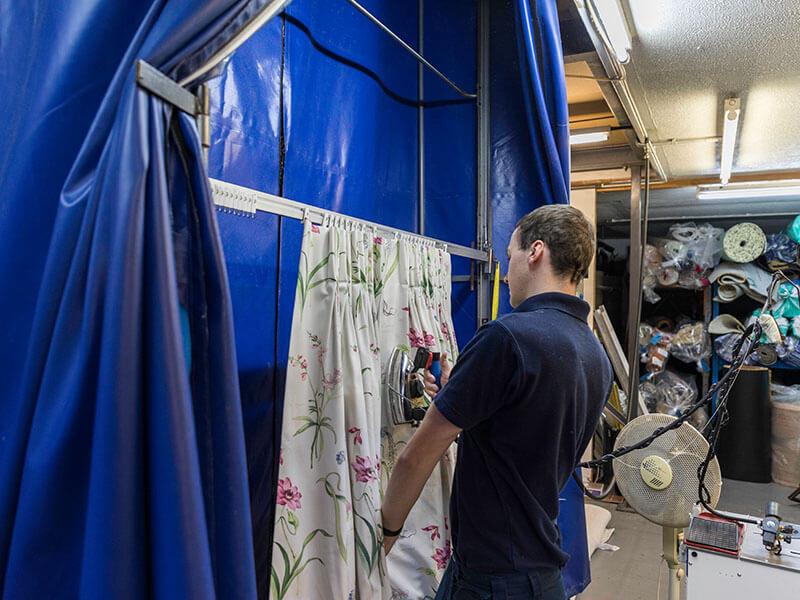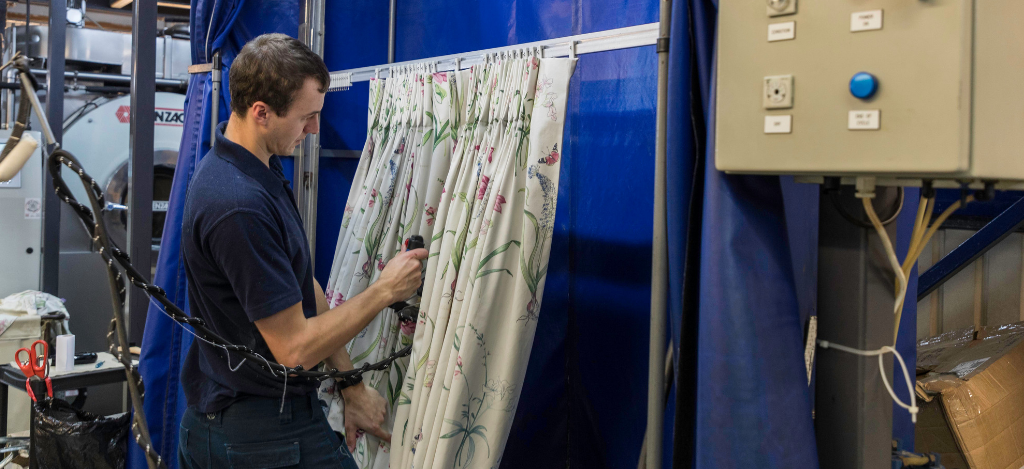How to Prevent Mould on Curtains
The last thing any homeowner needs is mouldy curtains, they look distasteful, no one wants to clean them, and they can even harm your health.
The ideal solution is to prevent mould from growing in the first place, which can be done by creating a clean, temperature-controlled house, free from damp.
Regular cleaning
As with most areas of home maintenance, the best way to upkeep your belongings is with regular cleaning.
To protect your curtains from mould, make sure you vacuum all the furnishings in your home frequently and occasionally dry-clean them.
Also, wipe down your windows, the surrounding areas, and Venetian blinds or shutters with warm water and detergent.
Try to buy window coverings which are aluminium or PVC for the bathrooms and kitchens, so they are resistant to moisture and easy to clean.
You also need to make sure you’re cleaning your curtains properly too!
Regularly washing your curtains can help remove any mould spores that may be present and prevent them from growing.
Make sure to follow the care instructions on the label of your curtains to avoid damaging them during washing though.

Ventilation
Mould thrives in damp conditions, so it is a good idea to prevent moisture build-up by ventilating your house.
When you are home, open the doors and windows to encourage air flow and let sunlight in. Installing an exhaust hood above your stove in the kitchen, and an extractor fan in the bathroom, will help to remove steam from the house.
Don’t hang up clothes to dry inside, and check if your clothes dryer is vented outside, because if not, that could contribute to a lot of damp heat in the room.
If your curtains do become wet, make sure to dry them thoroughly as soon as you can.
Hang them up to air dry in a well-ventilated area, and avoid leaving them damp for extended periods of time.
Temperature
Another method of preventing the growth of mould on curtains is to regulate the temperature in your house.
By adding double glazing to the windows, and insulating the floors, walls, and ceilings, the building won’t be so affected by hot or cold weather.
If you invest in blinds or other window coverings to go under your curtains, it will also add more insulation and temperature control to the house.
Use mould-resistant materials
When purchasing curtains, consider choosing ones made from mould-resistant materials, such as polyester or nylon.
These materials are less likely to absorb moisture than natural fabrics like cotton or linen, which can make them much more resistant to mould growth.
By choosing the right materials from the get-go, you can ensure that your curtains stay mould free, leaving you with more time to focus on more important things around the home!
Prevent moisture
Even if you have a well-ventilated house, it is still a good idea to create the least amount of moisture possible.
Damp usually creeps in from outside on wet, rainy days through gaps in walls and window frames.
Water can also pool in places it shouldn’t if stormwater isn’t being discharged properly or guttering is malfunctioning. The solution is to frequently check your drainage and guttering and make sure everything is working smoothly.
If you have curtains in your kitchen, especially near your sink, consider swapping them out for metal blinds or something that can better deal with the wet environment.
You can also consider investing in a humidifier for damp areas of the home to add another line of defence against moistur
How to remove mould from curtains
For cases which aren’t too extreme, you can spray stain remover onto the mouldy areas, scrub with a stiff-bristled brush, and then machine wash on a low temperature with some baking soda.
Dry the curtains by hanging them up outside, don’t use the dryer as it will make the mould stains harder to remove.
If that doesn’t work, you can try the old fashioned method of covering the curtains with lemon juice and salt and rubbing the stains, then rinsing the material out.
However, the most reliable way to remove mould from curtains is to hire a professional curtain cleaning service which will ensure a thorough, long-lasting solution.

What is the difference between mould and mildew?
While often used interchangeably, mould and mildew are distinct types of fungi that can affect your curtains. Understanding the difference can help you tackle the problem more effectively.
Mildew is typically a surface fungus that appears as a flat patch of grey or white on fabric surfaces. It’s often described as powdery and can be easier to remove than mould. Mould, on the other hand, can penetrate deeper into materials and often appears fuzzy or slimy. It comes in various colours, including black, green or blue.
Both mould and mildew thrive in moist environments and can cause similar issues in your home. However, mould is generally considered a more severe problem and can pose greater health risks if left untreated.
How to prevent mildew
Preventing mildew on your curtains involves many of the same strategies as preventing mould. Here are some additional tips to keep your curtains mildew-free:
- Ensure proper ventilation
Open windows regularly to allow fresh air to circulate, particularly after showering or cooking.
- Use moisture-absorbing products
Place silica gel packets or activated charcoal near your curtains to absorb excess moisture.
- Apply fabric protectors
Consider using a fabric protector spray designed to resist mildew on your curtains.
- Regularly inspect and clean
Check your curtains frequently for signs of mildew and clean them promptly if you spot any.
- Use mildew-resistant curtains
When purchasing new curtains, look for fabrics treated with mildew-resistant chemicals.
Minimise condensation on windows
Condensation on windows is a common culprit for mould and mildew growth on curtains. Here are some strategies to reduce window condensation:
- Improve insulation
Use double-glazed windows or add storm windows to reduce temperature differences between indoor and outdoor air.
- Use window treatments wisely
Keep curtains open during the day to allow air circulation and prevent moisture from getting trapped between the curtains and windows.
- Install extractor fans
Use fans in high-moisture areas like kitchens and bathrooms to remove humid air.
- Maintain consistent indoor temperature
Avoid large temperature fluctuations, which can increase condensation.
- Wipe down windows
Regularly wipe away any moisture that accumulates on your windows, especially in the morning.
Additional tips for preventing mould and mildew
To further protect your curtains from mould and mildew, consider these additional measures:
- Increase airflow by opening windows to lower humidity levels and keep blinds and curtains open during the day.
- Run a dehumidifier in problem rooms to maintain humidity below 50 percent. You should also address any sources of excess moisture like leaks.
- Vacuum your curtains regularly to remove dust and dirt build-up where mould can grow.
- Wash curtains every few months to kill developing mould and mildew spores before they spread.
- Take down and fully dry any curtains exposed to leaks or heavy condensation.
Treat mould fast
If you do notice mould growing on your curtains, the speed at which you act is just as important as the methods you use to get rid of the mould, so make sure that you get to work as quickly as possible before the mould starts to grow and spread.
Try to inspect your curtains regularly to see if you can see any mould growing.
What might just seem like a dark speck from far away might actually be mould, so it pays to be thorough!
If you need a professional curtain cleaning service to remove the mould from your curtains, John Frederick can help.
We provide a close inspection and measuring of the curtains beforehand, and then after an expert cleaning in our on-site facilities, your beautifully fresh curtains are bagged ready for rehanging.
Here at John Frederick, we have over 85 years of experience with both commercial and domestic customers all across London, so get in touch with our friendly team today.
John Frederick is based in Hendon, but provides cleaning services throughout the Greater London area, including Ascot, Weybridge & Bushey.
John Frederick’s are expert carpet, upholstery, curtain & blind cleaners. They also supply a wide range of curtains & blinds and carpet & flooring options to customers throughout London.



